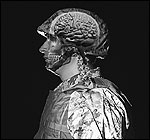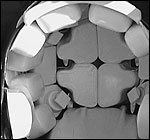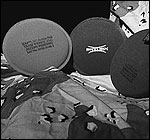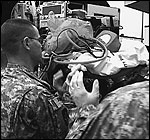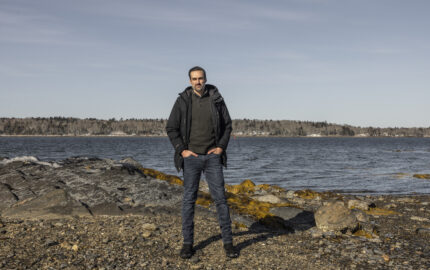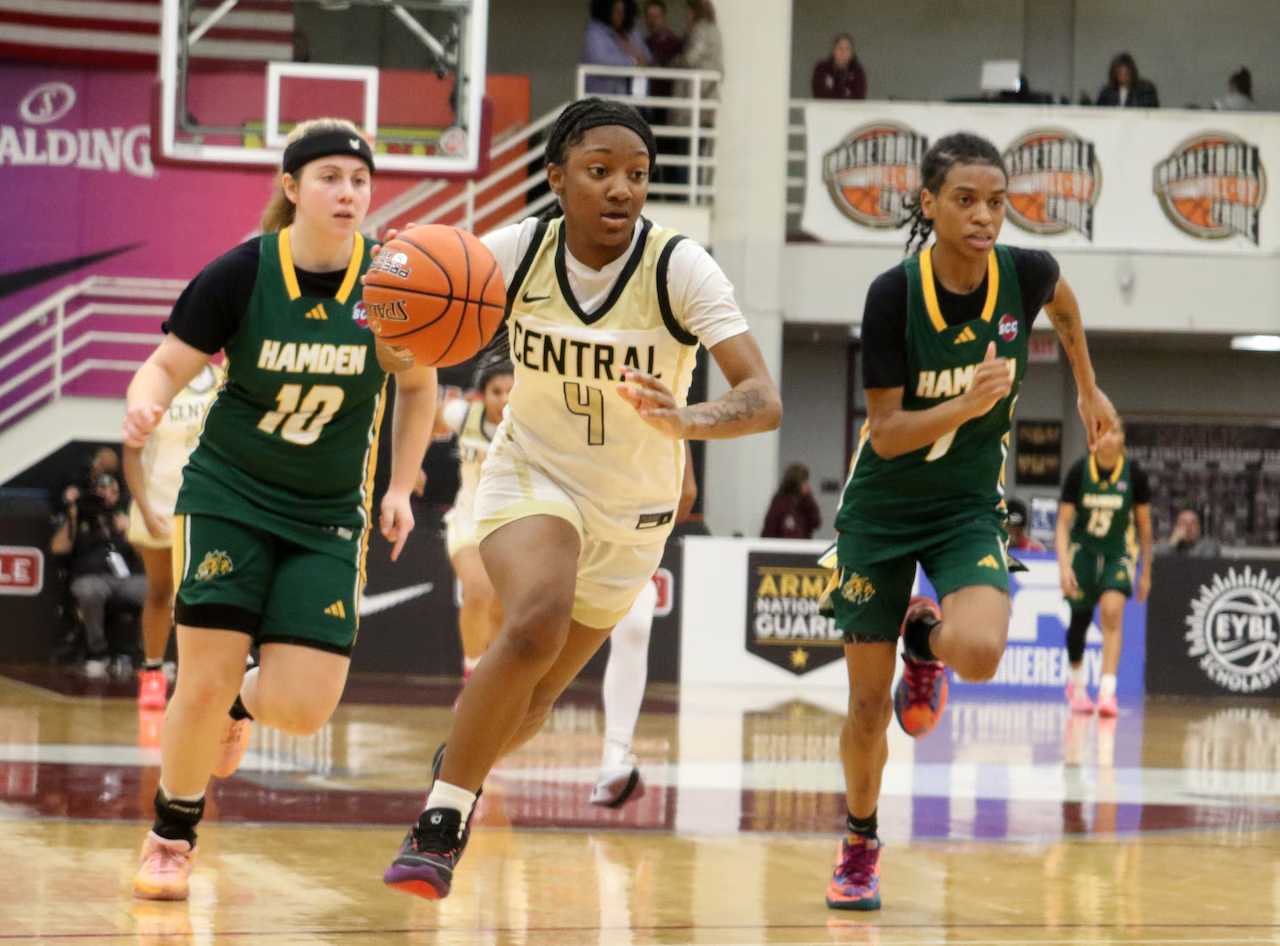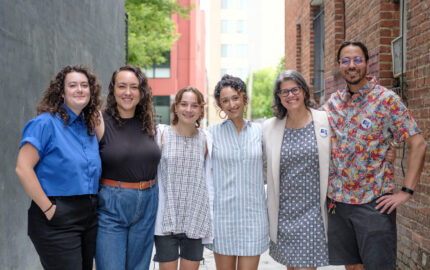A giant military cargo plane rumbles to a stop on a dry, windswept runway in Iraq’s embattled capital city. A U.S. cabinet member, a congressman, and their entourage ease their way off the noisy aircraft. A television news crew who tagged along also jumps into the sun, dry air, and 120-degree heat—not to mention the expected gunfire and explosions—in this foreign land. The reporter and photographer had traveled 12,000 miles on five planes, including this military transport, to get here.
This could be a crew from CNN, Fox News, ABC, NBC or CBS, but it isn’t. They are from WISH-TV in Indianapolis—a local TV station that has sent this team far from home to report on a story that has strong local roots. In fact, this was WISH’s second trip to Iraq, and this time our story turned out to be a rare glimpse at a significant issue. The reports by anchor/reporter Karen Hensel and photographer Eric Miller, edited by Doug Moon, were broadcast in the fall of 2006 and exposed a soft underbelly in the U.S. Marine Corps’ armor: the helmets that were supposed to protect their heads. Our series of stories, called “Command Mistake,” was recognized with a Peabody Award.
This reporting experience reminded us of just what constitutes “local” news these days. Many local TV news departments went “hyperlocal” a few years ago, with a just-around-the-block focus—after newspapers began their zoned editions phase more than a decade ago. So an international assignment like this one would seem at odds with our mission. But a closer look reveals how these various approaches to news reporting can coexist.
Following Local Leads
Hensel’s father is a former Marine, and his experiences as a veteran have connected her through the years with situations faced by veterans. At the outset of the Iraq War, she helped to lead our station’s drive to send air cooling “misters” to Americans fighting there. She’s also reported on delays in veterans receiving benefits owed to them and about a Veterans Administration (VA) security breach. Viewers know that she is interested in such stories, so soldiers and Marines, as well as veterans, often contact her to give her leads on possible stories.
That’s how “Command Mistake” began. In January 2006, “This guy writes and says, ‘I understand there’s padding. How do I get it?’” Hensel recalled. This e-mail message, sent to her from a soldier in Iraq, led Hensel to ask a lot of questions about this added padding that fits inside of helmets. She wanted to find out why soldiers and Marines need this extra cushioning pad for their helmets and why, if it’s needed, the helmets don’t already have it. And why, Hensel wondered, are the soldiers themselves having to pay for this padding?
In a short time, Hensel learned a lot about American military helmets, head injuries, and the Iraq War. Much of it required little more than some old-fashioned digging—and that she did by talking with military people in Central Indiana. “What really hit me was when the VA set up four polytrauma units stateside to deal with all the head injuries and other serious injuries,” said Hensel. “That told me the numbers were bigger than we knew.”
But she learned that the Pentagon wasn’t providing such numbers. Therefore, it took a lot more digging for her to establish connections among these helmet pads, head injuries, and what turns out to be the nature of warfare in Iraq.
Surprisingly, that’s when the story became very local.
By this time, Hensel had collected plenty of helmets to compare to the standard issue military helmet, including helmets used by players on the Indianapolis Colts and Indiana University team. Each of these helmets, she discovered, had much more padding than a soldier’s helmet, which, in 2005-2006, was still known as a “sling” helmet. When the Iraq War began, American troops wore a modern helmet with a Kevlar shell, but the interior still featured a sling design similar to the helmets dating back to World War II. This sling-style webbing suspended the helmet above the soldier’s head, but there were no cushioning pads to create a snug fit.
What’s the difference between webbing and padding? Hensel found that it’s the difference between severe brain injury and no injury at all. That’s because in this war, she reported, “for the first time, more soldiers are dying from bomb blasts than from bullets.”
The outer Kevlar might protect a soldier’s head from a piercing wound, but the webbing inside the helmet actually contributes to a concussion injury when the energy from a roadside bomb blast travels from the ground up to the helmet and slams the Kevlar helmet against a soldier’s head. That force leads to intracranial bleeding of the brain.
The results for the soldier or Marine range from obviously catastrophic—loss of motor skills, speech and memory—to more subtle delays that can last for months or years.
Hensel uncovered government research that had revealed recently the danger of roadside blasts from IED’s (Improvised Explosive Devices). This research explained how the energy from those explosions contributed to brain injuries. But she also dug up a huge disconnect: Despite the research and despite the U.S. Army’s decision to add cushioning padding to its helmets, the Marine Corps adamantly refused to follow the Army’s lead. That meant that Marines were left to improvise their own field installation of padding, in the same fashion that American troops have been “up-armoring” Humvees for years.
Even though Hensel’s findings certainly had international significance, still much of her reporting continued to be done near home. She documented what researchers were doing at Indiana University as they placed sensors in football helmets to measure force impact and alert trainers to players taking too much punishment. Hensel’s reporting showed how the nation’s leading football helmet designer, Riddell, was improving its helmets during the first three years of the Iraq War, while at the same time helmet design remained at a practical standstill at the Pentagon.
Hensel also discovered that two of seven companies manufacturing helmet padding also were located in Indiana. For years, they’d sold pads directly to worried parents of soldiers and Marines. When the Army authorized helmet padding, they won contracts and became direct suppliers.
Going Far, Remaining Local
After a couple of months of research, Hensel began sharing the helmet padding story with her audience in Indianapolis. The first story aired in March 2006. Others followed. In June, she reported on the congressional hearings that looked into brain injury from roadside bomb blasts.
Even before this, she’d begun trying to convince her bosses that to tell her story fully required a reporting trip to Iraq. At that time I was the assistant news director, and Tom Cochrun was news director at the station. While we supported the concept of Hensel making such a trip, our support wasn’t without reservations.
A trip to a war zone is fraught with more dangers than bombs and bullets. What if our contacts could not deliver on access they’d promised to soldiers and Marines? What if we ran into difficulty in securing visas in Kuwait? What if the commercial flights we take are delayed and Hensel and Miller miss their ride into Iraq on a military transport? With all of these uncertainties, we were concerned about whether they could get the story and do so safely. But we also understood that Hensel had exhausted the newsgathering she could do here. If she wanted to tell the whole story, she had to go to Iraq.
WISH-TV President and General Manager Jeff White is energetic and passionate about his station being a local leader. Ultimately, this decision was his to make, and though it was an expensive proposition, money wasn’t his top concern. Besides his crew’s safety, what concerned him most was whether Hensel would return with a story that our viewers would care about.
In two meetings, Hensel convinced all of her bosses that the Iraq trip was the right way to go. Perhaps one of the strongest selling points—aside from the evident passion she had to tell this story—was her reminder of the many local angles she’d already pursued. She had never forgotten that first e-mail—the one from a local soldier asking if she knew how to acquire a little after-market improvement to a standard-issue helmet. Hensel convinced all of us that if her curiosity was piqued by this query from an Indiana soldier, then her viewers would be interested, too.
“Command Mistake” was one of several recent WISH-TV news series involving overseas reporting trips. Our crews logged tens of thousands of miles from 2004 through 2006, with much of the reporting focused on local soldiers serving in distant lands. Anchor Debby Knox and photographer Bill Fisher profiled Indiana Guard troops on peacekeeping duty in Bosnia. Reporter Pam Elliot and photographer David Hodge made the station’s first trip to Kuwait and Iraq, documenting the “up-armoring” of Humvees. Elliott also traveled to Afghanistan with photographer Jerry Peck to report on Indiana soldiers training Afghanistan’s new army in modern battlefield tactics.
All of these were dangerous assignments, but one that turned out to be almost deadly was not in a typical war zone. Anchor Eric Halvorson and photographer Kevin Conners traveled with Jim Morris, who headed the UN’s World Food Programme and is from Indiana, as he surveyed the destruction of the tsunami in Sri Lanka. Even though Morris had negotiated a truce to allow relief workers to distribute food, rebel troops fired on their helicopter.
The currency common to these assignments was the thread of local connections stretching from Indiana to overseas and back in news stories we broadcast. But not all of our “international” reporting—with a local angle—required travel. In early 2005, reporter Mary McDermott and photographer Ron Nakasone began documenting the physical, emotional and personal costs of the war in Iraq. Her series, “Wounds of War,” focused on an Indiana veteran named Nick Bennett, who was later profiled by members of the national news media. Bennett has endured surgery after surgery for severe physical wounds. McDermott’s stories also showed how tough it is on families financially when the chief breadwinner has to leave his or her job and answer the call to active duty.
What Local Audiences Want
It remains true, however, that most of any local station’s news coverage is dedicated to purely local issues; there are proposed tax increases and political races, houses on fire and crime on the rise. And weather and daily events are consistent ingredients. Yet research shows that many viewers want their local TV station to cover it all. Be local, they say, but don’t forget to tell us about what else is going on in the world, too.
That sentiment is reflected in surveys conducted by Frank N. Magid Associates, the TV consulting firm. Magid has tracked local viewers’ interest in national/international news and noted a significant change in attitudes after the attacks of September 11, 2001. Using a 1-10 scale, with 10 being interested in national news and one reflecting interest in only local news, before 9/11, 53 percent of viewers (surveyed in 10 television markets) preferred local news only. After 9/11, just 23 percent of viewers wanted to know only about life in their hometown. Magid found the biggest change in the middle of the scale, with 39 percent favoring a blend of local and national news before 9/11 and 64 percent preferring the blend after 9/11.
“It simply means that there is a dependency viewers have on their local news to inform them about the important national and international news that is happening and if it can be brought down to the local level, so much the better,” says Richard Haynes, senior vice president, research, Frank N. Magid Associates.
To satisfy such viewer demands, Haynes recommends localizing an international story—a time-honored tradition among local stations. But it can also mean traveling to the source of the story overseas. Yet Haynes argues that national and international news must still be presented under a local umbrella. This guidance drives a lot of what we do at WISH-TV. Travel is never authorized simply for the sake of a trip. Our general manager’s thinking is correct: If the viewers don’t find some connection to their own lives with the news being reported to them, it doesn’t matter where the story originates or what its intrinsic value might be. Local means local, even when the story originates half a world away.
Kevin Finch is the news director at WISH-TV in Indianapolis, Indiana.
This could be a crew from CNN, Fox News, ABC, NBC or CBS, but it isn’t. They are from WISH-TV in Indianapolis—a local TV station that has sent this team far from home to report on a story that has strong local roots. In fact, this was WISH’s second trip to Iraq, and this time our story turned out to be a rare glimpse at a significant issue. The reports by anchor/reporter Karen Hensel and photographer Eric Miller, edited by Doug Moon, were broadcast in the fall of 2006 and exposed a soft underbelly in the U.S. Marine Corps’ armor: the helmets that were supposed to protect their heads. Our series of stories, called “Command Mistake,” was recognized with a Peabody Award.
This reporting experience reminded us of just what constitutes “local” news these days. Many local TV news departments went “hyperlocal” a few years ago, with a just-around-the-block focus—after newspapers began their zoned editions phase more than a decade ago. So an international assignment like this one would seem at odds with our mission. But a closer look reveals how these various approaches to news reporting can coexist.
Following Local Leads
Hensel’s father is a former Marine, and his experiences as a veteran have connected her through the years with situations faced by veterans. At the outset of the Iraq War, she helped to lead our station’s drive to send air cooling “misters” to Americans fighting there. She’s also reported on delays in veterans receiving benefits owed to them and about a Veterans Administration (VA) security breach. Viewers know that she is interested in such stories, so soldiers and Marines, as well as veterans, often contact her to give her leads on possible stories.
That’s how “Command Mistake” began. In January 2006, “This guy writes and says, ‘I understand there’s padding. How do I get it?’” Hensel recalled. This e-mail message, sent to her from a soldier in Iraq, led Hensel to ask a lot of questions about this added padding that fits inside of helmets. She wanted to find out why soldiers and Marines need this extra cushioning pad for their helmets and why, if it’s needed, the helmets don’t already have it. And why, Hensel wondered, are the soldiers themselves having to pay for this padding?
In a short time, Hensel learned a lot about American military helmets, head injuries, and the Iraq War. Much of it required little more than some old-fashioned digging—and that she did by talking with military people in Central Indiana. “What really hit me was when the VA set up four polytrauma units stateside to deal with all the head injuries and other serious injuries,” said Hensel. “That told me the numbers were bigger than we knew.”
But she learned that the Pentagon wasn’t providing such numbers. Therefore, it took a lot more digging for her to establish connections among these helmet pads, head injuries, and what turns out to be the nature of warfare in Iraq.
Surprisingly, that’s when the story became very local.
By this time, Hensel had collected plenty of helmets to compare to the standard issue military helmet, including helmets used by players on the Indianapolis Colts and Indiana University team. Each of these helmets, she discovered, had much more padding than a soldier’s helmet, which, in 2005-2006, was still known as a “sling” helmet. When the Iraq War began, American troops wore a modern helmet with a Kevlar shell, but the interior still featured a sling design similar to the helmets dating back to World War II. This sling-style webbing suspended the helmet above the soldier’s head, but there were no cushioning pads to create a snug fit.
What’s the difference between webbing and padding? Hensel found that it’s the difference between severe brain injury and no injury at all. That’s because in this war, she reported, “for the first time, more soldiers are dying from bomb blasts than from bullets.”
The outer Kevlar might protect a soldier’s head from a piercing wound, but the webbing inside the helmet actually contributes to a concussion injury when the energy from a roadside bomb blast travels from the ground up to the helmet and slams the Kevlar helmet against a soldier’s head. That force leads to intracranial bleeding of the brain.
The results for the soldier or Marine range from obviously catastrophic—loss of motor skills, speech and memory—to more subtle delays that can last for months or years.
Hensel uncovered government research that had revealed recently the danger of roadside blasts from IED’s (Improvised Explosive Devices). This research explained how the energy from those explosions contributed to brain injuries. But she also dug up a huge disconnect: Despite the research and despite the U.S. Army’s decision to add cushioning padding to its helmets, the Marine Corps adamantly refused to follow the Army’s lead. That meant that Marines were left to improvise their own field installation of padding, in the same fashion that American troops have been “up-armoring” Humvees for years.
Even though Hensel’s findings certainly had international significance, still much of her reporting continued to be done near home. She documented what researchers were doing at Indiana University as they placed sensors in football helmets to measure force impact and alert trainers to players taking too much punishment. Hensel’s reporting showed how the nation’s leading football helmet designer, Riddell, was improving its helmets during the first three years of the Iraq War, while at the same time helmet design remained at a practical standstill at the Pentagon.
Hensel also discovered that two of seven companies manufacturing helmet padding also were located in Indiana. For years, they’d sold pads directly to worried parents of soldiers and Marines. When the Army authorized helmet padding, they won contracts and became direct suppliers.
Going Far, Remaining Local
After a couple of months of research, Hensel began sharing the helmet padding story with her audience in Indianapolis. The first story aired in March 2006. Others followed. In June, she reported on the congressional hearings that looked into brain injury from roadside bomb blasts.
Even before this, she’d begun trying to convince her bosses that to tell her story fully required a reporting trip to Iraq. At that time I was the assistant news director, and Tom Cochrun was news director at the station. While we supported the concept of Hensel making such a trip, our support wasn’t without reservations.
A trip to a war zone is fraught with more dangers than bombs and bullets. What if our contacts could not deliver on access they’d promised to soldiers and Marines? What if we ran into difficulty in securing visas in Kuwait? What if the commercial flights we take are delayed and Hensel and Miller miss their ride into Iraq on a military transport? With all of these uncertainties, we were concerned about whether they could get the story and do so safely. But we also understood that Hensel had exhausted the newsgathering she could do here. If she wanted to tell the whole story, she had to go to Iraq.
WISH-TV President and General Manager Jeff White is energetic and passionate about his station being a local leader. Ultimately, this decision was his to make, and though it was an expensive proposition, money wasn’t his top concern. Besides his crew’s safety, what concerned him most was whether Hensel would return with a story that our viewers would care about.
In two meetings, Hensel convinced all of her bosses that the Iraq trip was the right way to go. Perhaps one of the strongest selling points—aside from the evident passion she had to tell this story—was her reminder of the many local angles she’d already pursued. She had never forgotten that first e-mail—the one from a local soldier asking if she knew how to acquire a little after-market improvement to a standard-issue helmet. Hensel convinced all of us that if her curiosity was piqued by this query from an Indiana soldier, then her viewers would be interested, too.
“Command Mistake” was one of several recent WISH-TV news series involving overseas reporting trips. Our crews logged tens of thousands of miles from 2004 through 2006, with much of the reporting focused on local soldiers serving in distant lands. Anchor Debby Knox and photographer Bill Fisher profiled Indiana Guard troops on peacekeeping duty in Bosnia. Reporter Pam Elliot and photographer David Hodge made the station’s first trip to Kuwait and Iraq, documenting the “up-armoring” of Humvees. Elliott also traveled to Afghanistan with photographer Jerry Peck to report on Indiana soldiers training Afghanistan’s new army in modern battlefield tactics.
All of these were dangerous assignments, but one that turned out to be almost deadly was not in a typical war zone. Anchor Eric Halvorson and photographer Kevin Conners traveled with Jim Morris, who headed the UN’s World Food Programme and is from Indiana, as he surveyed the destruction of the tsunami in Sri Lanka. Even though Morris had negotiated a truce to allow relief workers to distribute food, rebel troops fired on their helicopter.
The currency common to these assignments was the thread of local connections stretching from Indiana to overseas and back in news stories we broadcast. But not all of our “international” reporting—with a local angle—required travel. In early 2005, reporter Mary McDermott and photographer Ron Nakasone began documenting the physical, emotional and personal costs of the war in Iraq. Her series, “Wounds of War,” focused on an Indiana veteran named Nick Bennett, who was later profiled by members of the national news media. Bennett has endured surgery after surgery for severe physical wounds. McDermott’s stories also showed how tough it is on families financially when the chief breadwinner has to leave his or her job and answer the call to active duty.
What Local Audiences Want
It remains true, however, that most of any local station’s news coverage is dedicated to purely local issues; there are proposed tax increases and political races, houses on fire and crime on the rise. And weather and daily events are consistent ingredients. Yet research shows that many viewers want their local TV station to cover it all. Be local, they say, but don’t forget to tell us about what else is going on in the world, too.
That sentiment is reflected in surveys conducted by Frank N. Magid Associates, the TV consulting firm. Magid has tracked local viewers’ interest in national/international news and noted a significant change in attitudes after the attacks of September 11, 2001. Using a 1-10 scale, with 10 being interested in national news and one reflecting interest in only local news, before 9/11, 53 percent of viewers (surveyed in 10 television markets) preferred local news only. After 9/11, just 23 percent of viewers wanted to know only about life in their hometown. Magid found the biggest change in the middle of the scale, with 39 percent favoring a blend of local and national news before 9/11 and 64 percent preferring the blend after 9/11.
“It simply means that there is a dependency viewers have on their local news to inform them about the important national and international news that is happening and if it can be brought down to the local level, so much the better,” says Richard Haynes, senior vice president, research, Frank N. Magid Associates.
To satisfy such viewer demands, Haynes recommends localizing an international story—a time-honored tradition among local stations. But it can also mean traveling to the source of the story overseas. Yet Haynes argues that national and international news must still be presented under a local umbrella. This guidance drives a lot of what we do at WISH-TV. Travel is never authorized simply for the sake of a trip. Our general manager’s thinking is correct: If the viewers don’t find some connection to their own lives with the news being reported to them, it doesn’t matter where the story originates or what its intrinsic value might be. Local means local, even when the story originates half a world away.
Kevin Finch is the news director at WISH-TV in Indianapolis, Indiana.

